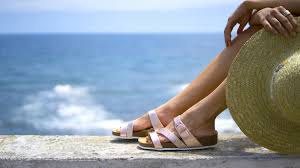Heading to the beach means relaxation, fun in the sun, and, of course, the perfect pair of sandals to keep your feet cool and comfortable. But with so many options available, how do you pick the best beach sandals for your feet? Whether you’re lounging by the shore, walking along the coast, or taking a dip in the water, your sandals should offer the right combination of comfort, style, and durability. Here’s a guide to help you choose the perfect beach sandals for your feet.
1. Consider the Fit
The fit is crucial when selecting the right beach sandals. Ill-fitting sandals can lead to blisters, discomfort, and foot pain, ruining your day at the beach. To find the perfect fit, keep these points in mind:
- Sizing: Make sure the sandals fit snugly but aren’t too tight. You should have enough room in the toe area to wiggle your toes, while the heel should sit comfortably without overhanging the edge of the sandal.
- Arch Support: Look for sandals with proper arch support to avoid foot strain. If you have flat feet or high arches, opt for sandals designed to accommodate your foot type.
- Adjustability: Adjustable straps or a back strap can help achieve a better fit, especially if you have a narrower or wider foot.
2. Material Matters
The materials used in your beach sandals will determine their comfort, durability, and how well they hold up in wet conditions. Here are some popular materials to consider:
- Rubber or EVA (Ethylene Vinyl Acetate): These materials are lightweight, water-resistant, and easy to clean, making them ideal for the beach. They also provide flexibility and cushioning.
- Leather: Leather sandals offer a more stylish look and can be comfortable, but they may not be as water-friendly. If you choose leather sandals, look for those with water-resistant treatments or designs that allow airflow.
- Synthetic Fabrics: Many brands offer sandals made from quick-drying synthetic materials. These can be a great option if you plan on spending a lot of time in and out of the water.
- Cork or Memory Foam Footbeds: For added comfort, sandals with a cork or memory foam footbed can mold to the shape of your foot, providing a personalized fit and extra cushioning for long hours of wear.
3. Look for Traction and Grip
When you’re walking on wet sand, rocks, or even by the pool, the last thing you want is to slip. Make sure your sandals provide good traction. Check the soles for non-slip designs, like grooves, ridges, or rubber treads. A sturdy grip will prevent you from losing your balance, especially when walking on wet or uneven surfaces.
4. Choose the Right Style for Your Activities
Not all beach sandals are created equal—different styles are designed for different activities. Consider what you’ll be doing at the beach before choosing a pair:
- Flip-Flops: These are classic beach sandals that are perfect for lounging and light walking. However, they may not provide enough support for long walks or active beach sports.
- Slides: Slide sandals are easy to slip on and off and work well for quick trips to the beach or the pool. They’re stylish and comfortable but may not offer as much foot support for extended wear.
- Sport Sandals: If you’re planning on doing more active activities like beach volleyball, hiking on coastal trails, or kayaking, look for sport sandals. These typically feature adjustable straps for a secure fit, sturdy soles for grip, and added arch
5. Prioritize Comfort and Cushioning
You’ll be on your feet a lot at the beach, whether you’re walking, standing, or playing in the sand. Look for sandals that provide cushioning and support. Memory foam, soft footbeds, and contoured insoles are great options to reduce pressure on your feet, making your time at the beach more enjoyable. Additionally, cushioned sandals can help reduce fatigue and soreness during longer walks or days out in the sun.
6. Think About Durability
Beach sandals should be able to withstand the elements—sand, saltwater, and sun exposure. When shopping for sandals, check the construction quality and how well the materials will hold up over time. Rubber, synthetic, and water-resistant materials tend to last longer when exposed to harsh conditions. It’s also a good idea to choose sandals that are easy to clean and maintain, as sand and salt can accumulate and damage delicate materials over time.
7. Style and Aesthetics
While comfort and durability are paramount, there’s no harm in wanting stylish sandals that look great with your beachwear. Consider the colors, patterns, and design elements that fit your personal style. Classic neutrals like black, tan, or navy are always safe choices, but if you want to make a statement, go for bright colors or fun patterns. The key is to find a balance between functionality and style.
8. Consider Your Foot Health Needs
If you have specific foot health concerns, like plantar fasciitis, bunions, or hammertoes, it’s crucial to choose sandals that address these issues. Orthopedic sandals are designed with specialized footbeds and arch supports to alleviate pain and discomfort. Some brands even offer customizable options that allow you to adjust the fit to suit your unique needs.
Final Thoughts
Choosing the perfect beach sandals is all about finding a pair that combines comfort, durability, support, and style. Whether you’re lounging on the sand, walking along the shore, or diving into the waves, the right sandals can make all the difference in your overall beach experience. Remember to consider factors like fit, material, traction, and your planned activities to ensure you pick the ideal pair for your feet. With the right sandals, you’ll be ready to enjoy every step on the beach in comfort and style.
